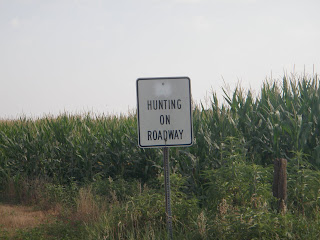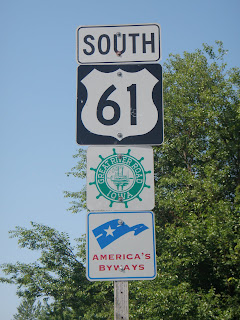The heat wave is still upon us, however the National Weather Service claimed it would break today. They lied. Now they are saying it won't break until Saturday. Only time will tell. The ride from Wapello, IA started with a crossing the Iowa River. The riders left very early...
The Iowa River looks peaceful.
Every now and then you see interesting signs...I wonder what they are hunting.
On the route we passed the Toolesboro Mounds. The visitor center was closed but it was a beautiful spot and 2 of the mounds were very visible. These mounds are a group of seven burial mounds on a bluff overlooking the Iowa River near where it joins the Mississippi River.
Of the seven mounds, only two are visible, the rest are off in the woods. One of the mounds maintained near the Center, known as Mound 2, is the largest of the remaining mounds, measuring 100 feet in diameter and 8 feet in height. This mound was possibly the largest Hopewell mound in Iowa.
In 1966, the Toolesboro mounds were designated as a National Historic Landmark.
Very interesting stop at the Toolesboro Mounds
One of many cute farmhouses on the ride.
Then in Burlington, Iowa I found Iowa's version of Lombard St. of San Franciso, CA fame. Not as long as Lombard St., but is was neat and the view was very nice as well!
Then in Burlington, Iowa I found Iowa's version of Lombard St. of San Franciso, CA fame. Not as long as Lombard St., but is was neat and the view was very nice as well!
Burlington, Iowa
Vicki L navigates the cobbles of Snake Alley like a pro!
Quite the view from the top of Snake Alley
To the left of the entrance to Snake Alley was the Phelps House Museum located in an elegant 19th century home. It features antique furnishings belonging to the Phelps family. Since this structure housed the city’s first Protestant hospital, there is also a medical memories display.
Named to the National Register of Historic Places in December of 1982, Heritage Hill lines the northern sector of downtown Burlington. Convenient access to commercial and cultural activities made the Hill socially desirable during the status-conscious period of 1870-1900.
The Great River Road, Iowa
Rich G and Bill K found another ice cream stop as they entered Fort Madison, Iowa!
Pretty flowers with a really big bee adorned an arbor on the grounds of the Ice Cream Shop.
I wonder what it means that the ice cream shop was located right outside the staff entrance to the Iowa State Penitentiary...
Iowa State Penitentiary, a maximum security prison was built in 1839 and served as territorial prison before Iowa was a state. It is one of the oldest correctional facilities west of the Mississippi. The original cell block completed in the early 1840's is still in use today. Currently the only maximum security prison in the state; it houses approximately 1,000 inmates.
Then it was onto downtown Ft Madison
Fort Madison was founded in 1838, is credited to General John Knapp, who named the town after the then current president, James Madison.
Fort Madison, located on the Mississippi River at one of the few places where the river runs east and west, has several historic places. There is the reconstructed Old Fort Madison, two historic train depots, historic homes and the world's largest double-decker swing span bridge.
The riverside park was very pretty and had a very nice veteran's memorial.
The restored old Ft Madison was rebuilt about 3 blocks from its original location because the original site is currently owned by a business. In 1808 Fort Madison, the first U.S. military post on the Upper Mississippi River, was established in what is now the state of Iowa. In part, the fort served to protect a government "factory" or trading post where area indians could exchange furs and hides for hunting knives, animal traps, blankets, iron tools, fish hooks and other manufactured goods. The post was also intended to secure the American frontier in the region.
The majority of area Indians were friendly toward the fort and traded peacefully at the government factory. From time to time, bands of unfriendly Sauk, Fox (Mesouakie), and Winnebagoe menanced Fort Madison under the partial leadership of the noted Souk warrior Black Hawk.
Following the outbreak of the War of 1812, tensions rose and faced with continuous harassment, LT Thomas Hamilton, the post commander, ordered the fort abandoned sometime in the late summer or early fall of 1813. Under the cover of darkness, the garrison slipped away down the river in boats, having set fires as they departed, which left the fort in flames.
The majority of area Indians were friendly toward the fort and traded peacefully at the government factory. From time to time, bands of unfriendly Sauk, Fox (Mesouakie), and Winnebagoe menanced Fort Madison under the partial leadership of the noted Souk warrior Black Hawk.
Following the outbreak of the War of 1812, tensions rose and faced with continuous harassment, LT Thomas Hamilton, the post commander, ordered the fort abandoned sometime in the late summer or early fall of 1813. Under the cover of darkness, the garrison slipped away down the river in boats, having set fires as they departed, which left the fort in flames.
It is very interesting to see the ingenuity of the soldiers.
I just had to document that, yes, I was here....
Thanks goodness I don't have to cook on this stove!
Reenacters were on hand and one demonstrated the firing of a flint lock musket.
The Ole' Mississippi River as seen from the top of the fort.
Looking down from the corner block of the fort at the interior of the fort.
Sitting proudly in port was the Catfish River Boat.
The Sante Fe Bridge [for the old Sante Fe Rail Line] was originally built in 1888. The current bridge was built in 1927. Measuring 525 feet, the bridge is the world's largest double-decker, swing span bridge. The top level accommodates vehicle traffic while the lower level provides two tracks for railroad traffic. The bridge rotates to allow river traffic to pass safely. The bridge over the Mississippi River connects Fort Madison, IA and unincorporated Niota, Illinois. In 1999, it was listed in the National Register of Historic Places under the title, Fort Madison Bridge.
The Albright "Betsy Ross House"
Jacob W. and William G. Albright were partners in Albright Brothers Mercantile Store. In 1857 they commissioned Marr & Creps to build this three story brick Italianate duplex as their families home. W. Albright, his wife Cynthia and family lived the left side. J.W. Albright, his wife Rachel and family lived the right side. Jacob's wife Rachel was the grand-daughter of Betsy Ross. The house is three stories tall with ceiling heights of 12 feet. Each residence consisted of 13 rooms and both homes were mirror images. This home is listed on the Historic National Registry.
The Albright "Betsy Ross House"
We are staying at the Super 8.
Tomorrow we are out of Iowa and in our ninth state [Washington, Oregon, Idaho, Montana, Wyoming, South Dakota, Nebraska, Iowa]...we overnight in Quincy, Illinois.






























No comments:
Post a Comment